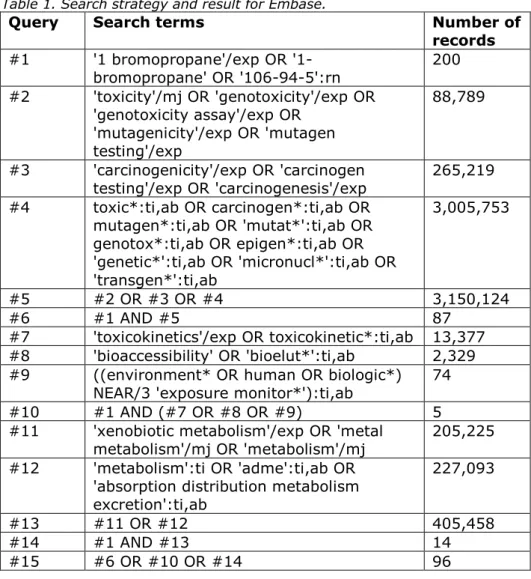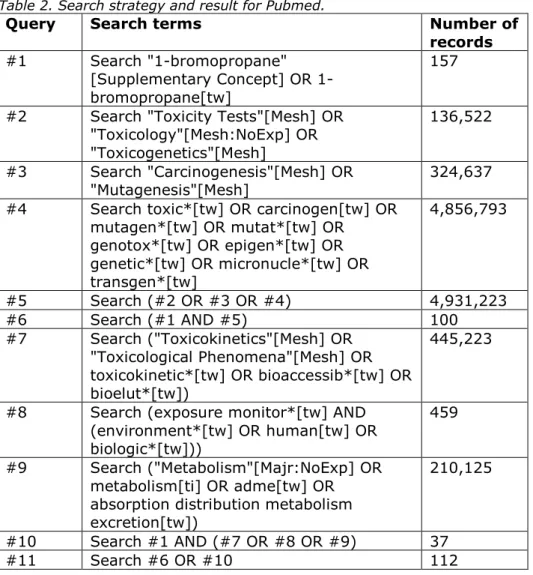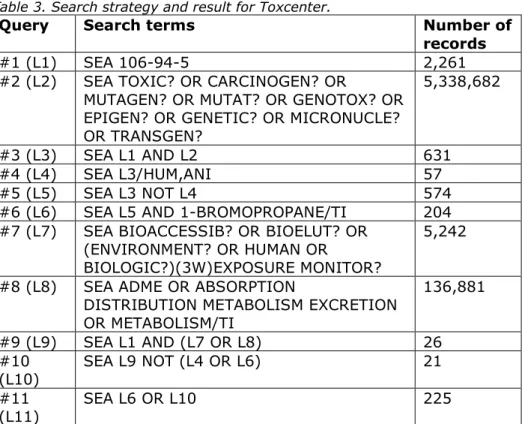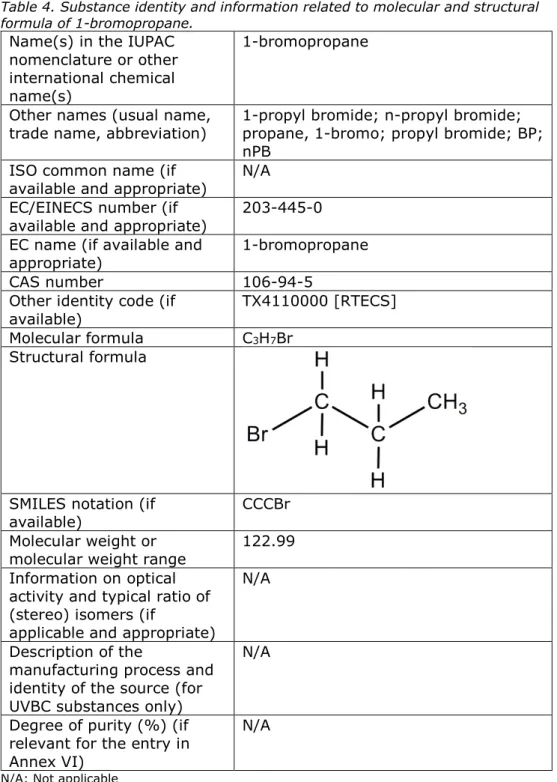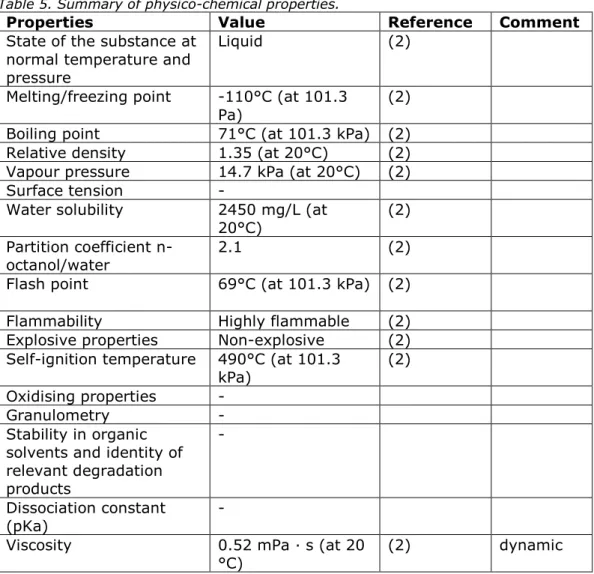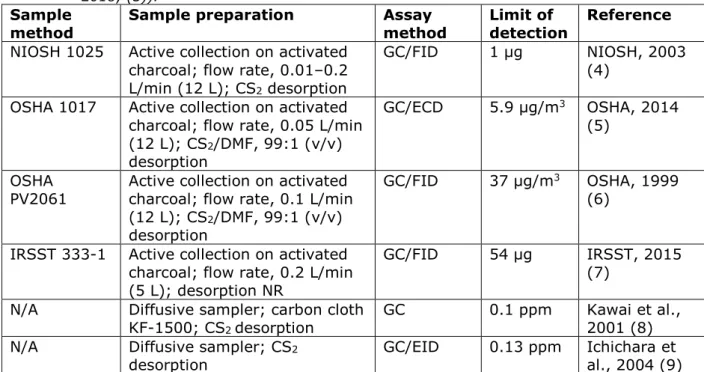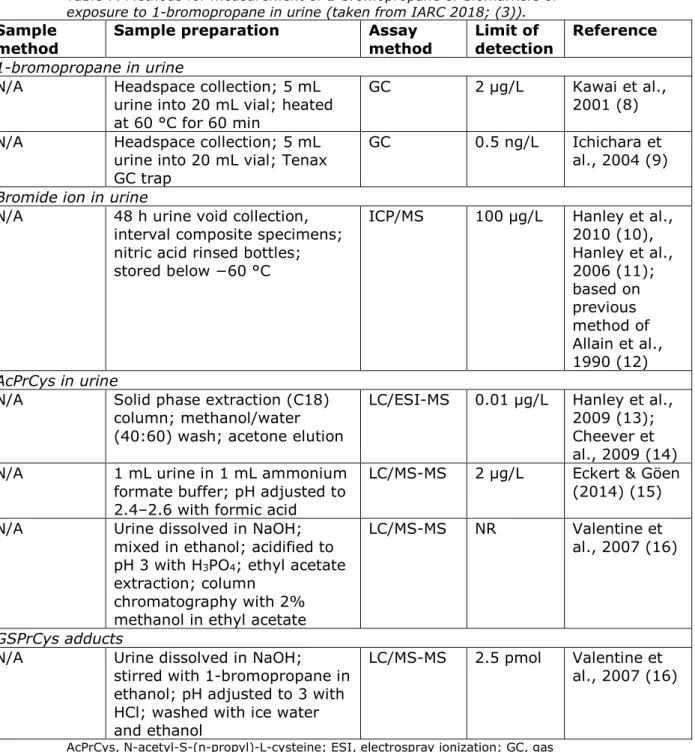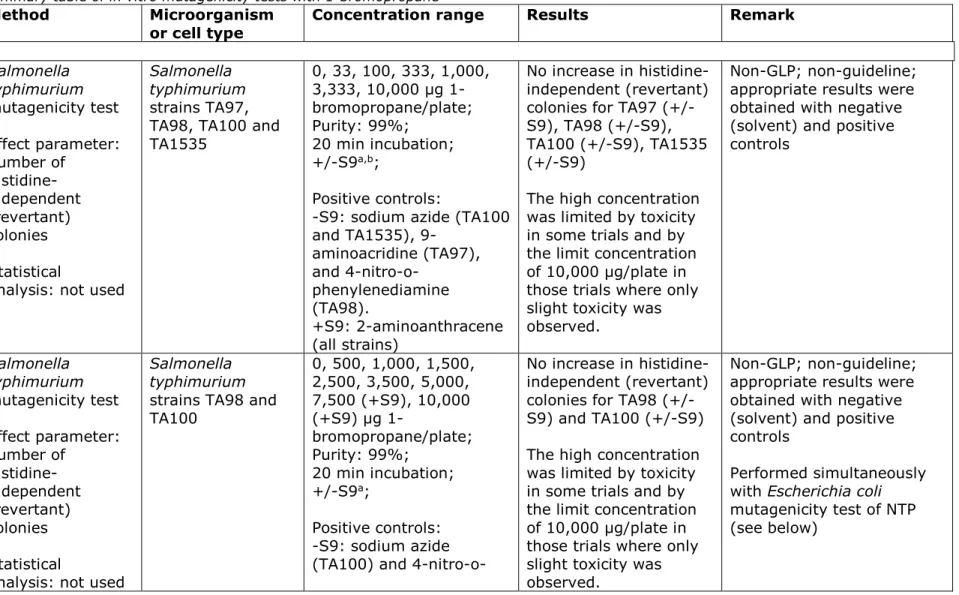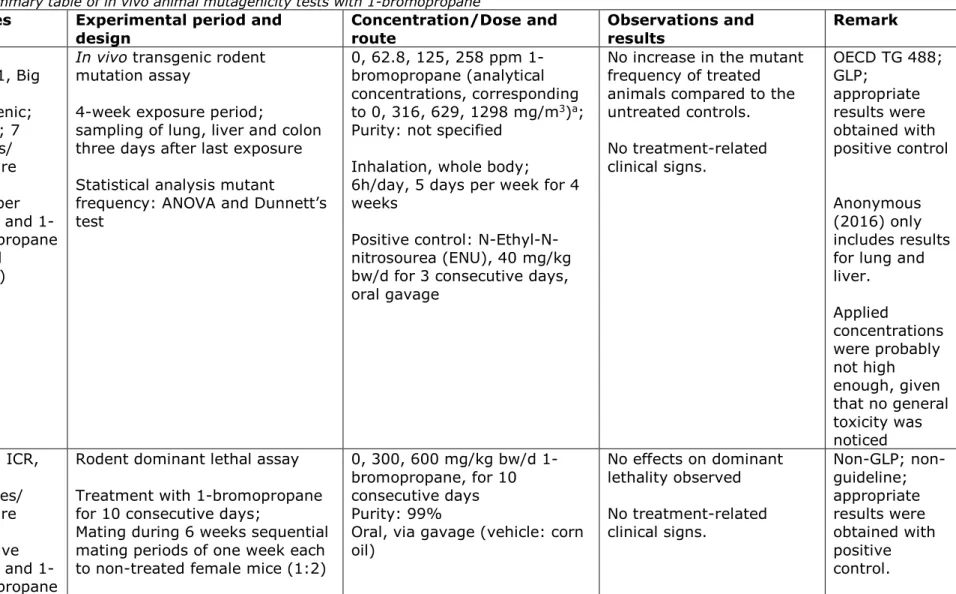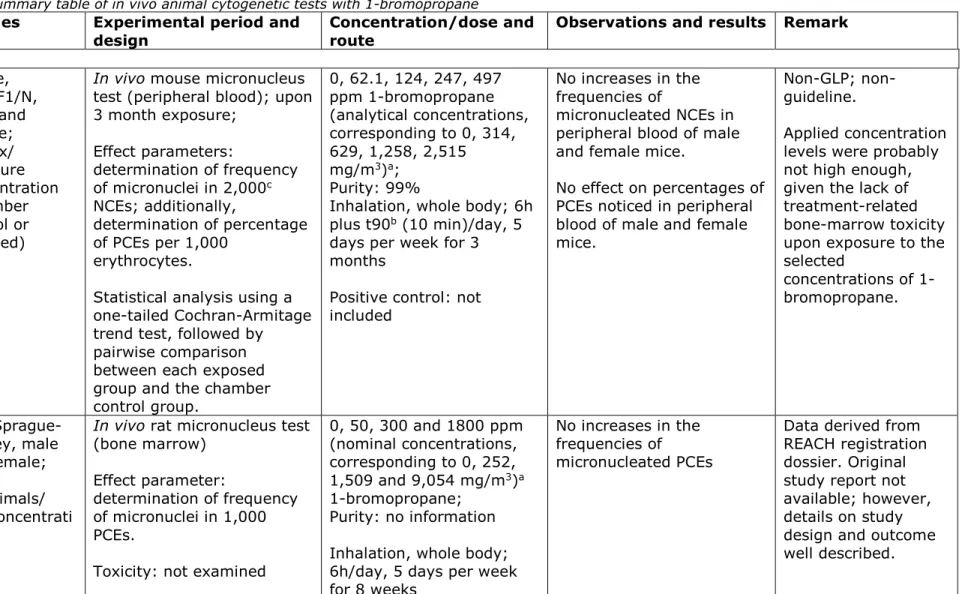An overview of the available data on
the mutagenicity and carcinogenicity
of 1-bromopropane
RIVM letter report 2020-0144 L. Geraets
Colophon
© RIVM 2020Parts of this publication may be reproduced, provided acknowledgement is given to the: National Institute for Public Health and the Environment, and the title and year of publication are cited.
DOI 10.21945/RIVM-2020-0144 L. Geraets (author), RIVM Contact:
Andre Muller
Centrum Veiligheid van Stoffen en Producten andre.muller@rivm.nl
This investigation was performed by order, and for the account, of The Health Council of the Netherlands, within the framework of the project ‘Literature reviews for use in advisory reports on substances’
Published by:
National Institute for Public Health and the Environment, RIVM
P.O. Box 1 | 3720 BA Bilthoven The Netherlands
Synopsis
An overview of the available data on the mutagenicity and carcinogenicity of 1-bromopropane
RIVM has carried out a literature search for information on the potential mutagenic and carcinogenic properties of 1-bromopropane. This
substance is used amongst others as a solvent for fats, waxes and resins.
The data found was summarised. At the request of the Dutch Minister of Social Affairs and Employment, the Health Council of the Netherlands will use the summaries to assess the mutagenic and carcinogenic properties and to provide a recommendation for its classification.
The assessment will be performed by the Health Council’s Subcommittee on Classifying Carcinogenic Substances. This subcommittee falls under the Dutch Expert Committee on Occupational Safety, which focuses on health risks associated with occupational exposure of workers to chemicals.
Publiekssamenvatting
1-Broompropaan: een overzicht van de beschikbare informatie over mogelijke kankerverwekkende en mutagene eigenschappen
De stof 1-broompropaan wordt onder andere gebruikt als oplosmiddel voor vetten, waxen en harsen. Het RIVM heeft in de wetenschappelijke literatuur onderzocht wat er bekend is over twee mogelijke schadelijke eigenschappen van deze stof. De vraag is of 1-broompropaan
kankerverwekkend is en erfelijke veranderingen kan veroorzaken door schade aan het DNA (mutageen).
De gevonden informatie is samengevat. De Gezondheidsraad gebruikt de samenvattingen om de mutagene en kankerverwekkende
eigenschappen te beoordelen. De Gezondheidsraad gebruikt de
samenvattingen ook voor een advies voor de classificatie van de stof dat op verzoek van de minister van Sociale Zaken en Werkgelegenheid (SZW) wordt opgesteld.
De genoemde beoordeling wordt uitgevoerd door de Subcommissie Classificatie van carcinogene stoffen. Deze subcommissie valt onder de Commissie Gezondheid en Beroepsmatige Blootstelling aan Stoffen (GBBS) van de Gezondheidsraad. De GBBS richt zich op
gezondheidsrisico’s door blootstelling aan chemische stoffen op de werkplek.
Contents
Summary — 9
1 Introduction — 11
2 Literature search strategy — 13
2.1 Embase — 13 2.2 PubMed — 13 2.3 Scopus — 14 2.4 Toxcenter — 14 2.5 ECHA database — 15 2.6 Secondary sources — 15
2.7 Overall evaluation of results literature search — 15
3 Substance identification — 17
3.1 Name and other identifiers of the substance — 17 3.2 Physico-chemical properties — 18
4 International classifications — 19
4.1 European Commission — 19 4.2 The Health Council — 19
4.3 IARC — 19
4.4 Other countries — 19
5 Monitoring — 21
5.1 Environmental exposure monitoring — 21 5.2 Biological exposure monitoring — 21
6 Manufacture and uses — 23
7 (Toxico)kinetics — 25
7.1 Human data — 25 7.2 Animal data — 25
8 Germ cell mutagenicity — 29
8.1 Summary of in vitro mutagenicity tests — 49 8.2 Summary of in vitro cytogenetic tests — 49 8.3 Summary of human data on mutagenicity — 49 8.4 Summary of in vivo animal mutagenicity tests — 49 8.5 Summary of in vivo animal cytogenetic tests — 55 8.6 Summary of additional data — 55
9 Carcinogenicity — 59
9.1 Observations in humans — 59 9.2 Animal experiments — 59
Summary
RIVM has carried out a literature search for information on the potential mutagenic and carcinogenic properties of 1-bromopropane. This
substance is used amongst others as a solvent for fats, waxes and resins.
Available data on in vitro mutagenicity testing of 1-bromopropane included bacterial mutagenicity tests with Salmonella typhimurium strains TA97, TA98, TA100, TA1535, TA1537, TA1538 and Escherichia coli strain WP2 uvrA and a mouse lymphoma assay. The in vivo
mutagenicity of 1-bromopropane was studied in a transgenic rodent mutation assay and two rodent dominant lethal assays. 1-Bromopropane was further tested in multiple in vivo micronucleus tests. Human data included assessment of DNA-damage using the comet assay in
leukocytes of occupationally exposed subjects and in ex vivo treated human whole blood. Additionally, an in vivo rat study and an in vitro study focusing on DNA- and GSH-adduct formation upon
1-bromopropane exposure was included as well.
No data on the carcinogenicity of 1-bromopropane in humans were found and no oral or dermal animal carcinogenicity studies were available. 1-Bromopropane was investigated in an inhalation carcinogenicity study in rats and mice.
Most studies were considered of sufficient quality.
The data found was summarised. At the request of the Dutch Minister of Social Affairs and Employment, the Health Council of the Netherlands will use the summaries to assess the mutagenic and carcinogenic properties and to provide a recommendation for its classification.
The assessment will be performed by the Health Council’s Subcommittee on Classifying Carcinogenic Substances. This subcommittee falls under the Dutch Expert Committee on Occupational Safety, which focuses on health risks associated with occupational exposure of workers to chemicals.
1
Introduction
The aim of current research is to identify and summarize the available data from studies with laboratory models, test animals and humans on the substance 1-bromopropane. The focus of current literature review will be on the mutagenic and carcinogenic properties of this substance. At the request of the Dutch Minister of Social Affairs and Employment, the Health Council of the Netherlands will use the summaries to assess the mutagenic and carcinogenic properties and to provide a
recommendation for its classification. The assessment will be performed by the Health Council’s Subcommittee on Classifying Carcinogenic Substances. This subcommittee falls under the Dutch Expert Committee on Occupational Safety, which focuses on health risks associated with occupational exposure of workers to chemicals.
Current RIVM-report does not include an assessment of the reported mutagenic and carcinogenic properties of 1-bromopropane, nor does it provide a recommendation for classification of the substance based on the CLP-criteria (1).
The literature search strategy which forms the basis of current literature overview is presented in chapter 2. In chapter 3 the substance identity of 1-bromopropane is provided. Chapter 4 presents information on international classifications of 1-bromopropane. Available information on monitoring (i.e. environmental and biological exposure monitoring) and manufacture and use is presented in chapters 5 and 6, respectively. A summary of the (toxico)kinetics of 1-bromopropane is described in chapter 7. Chapter 8 describes an overview of the data on mutagenicity. Finally, the data on carcinogenicity are presented in chapter 9.
2
Literature search strategy
A literature search for publications on genotoxicity and carcinogenicity of 1-bromopropane has been performed using various databases up to September 2020. Additionally, publications on (toxico)kinetics and monitoring were searched for as well. Below the literature search strategy is presented.
2.1 Embase
Table 1 presents the search terms and the results for the database Embase.
Table 1. Search strategy and result for Embase.
Query Search terms Number of
records #1 '1 bromopropane'/exp OR '1-bromopropane' OR '106-94-5':rn 200 #2 'toxicity'/mj OR 'genotoxicity'/exp OR 'genotoxicity assay'/exp OR 'mutagenicity'/exp OR 'mutagen testing'/exp 88,789 #3 'carcinogenicity'/exp OR 'carcinogen testing'/exp OR 'carcinogenesis'/exp 265,219 #4 toxic*:ti,ab OR carcinogen*:ti,ab OR mutagen*:ti,ab OR 'mutat*':ti,ab OR genotox*:ti,ab OR epigen*:ti,ab OR 'genetic*':ti,ab OR 'micronucl*':ti,ab OR 'transgen*':ti,ab 3,005,753 #5 #2 OR #3 OR #4 3,150,124 #6 #1 AND #5 87 #7 'toxicokinetics'/exp OR toxicokinetic*:ti,ab 13,377 #8 'bioaccessibility' OR 'bioelut*':ti,ab 2,329 #9 ((environment* OR human OR biologic*)
NEAR/3 'exposure monitor*'):ti,ab 74
#10 #1 AND (#7 OR #8 OR #9) 5
#11 'xenobiotic metabolism'/exp OR 'metal
metabolism'/mj OR 'metabolism'/mj 205,225 #12 'metabolism':ti OR 'adme':ti,ab OR
'absorption distribution metabolism excretion':ti,ab 227,093 #13 #11 OR #12 405,458 #14 #1 AND #13 14 #15 #6 OR #10 OR #14 96 2.2 PubMed
Table 2 presents the search terms and the results for the database Pubmed:
Table 2. Search strategy and result for Pubmed.
Query Search terms Number of
records
#1 Search "1-bromopropane" [Supplementary Concept] OR 1-bromopropane[tw]
157 #2 Search "Toxicity Tests"[Mesh] OR
"Toxicology"[Mesh:NoExp] OR "Toxicogenetics"[Mesh]
136,522 #3 Search "Carcinogenesis"[Mesh] OR
"Mutagenesis"[Mesh] 324,637 #4 Search toxic*[tw] OR carcinogen[tw] OR
mutagen*[tw] OR mutat*[tw] OR genotox*[tw] OR epigen*[tw] OR genetic*[tw] OR micronucle*[tw] OR transgen*[tw] 4,856,793 #5 Search (#2 OR #3 OR #4) 4,931,223 #6 Search (#1 AND #5) 100 #7 Search ("Toxicokinetics"[Mesh] OR "Toxicological Phenomena"[Mesh] OR toxicokinetic*[tw] OR bioaccessib*[tw] OR bioelut*[tw]) 445,223
#8 Search (exposure monitor*[tw] AND (environment*[tw] OR human[tw] OR biologic*[tw]))
459 #9 Search ("Metabolism"[Majr:NoExp] OR
metabolism[ti] OR adme[tw] OR absorption distribution metabolism excretion[tw])
210,125
#10 Search #1 AND (#7 OR #8 OR #9) 37
#11 Search #6 OR #10 112
2.3 Scopus
A search was performed in Scopus using the following search terms. ( ( ( CASREGNUMBER ( 106-94-5 ) ) OR ( TITLE-ABS-KEY (
1-bromopropane ) ) ) AND ( TITLE-ABS-KEY ( toxic* OR carcinogen* OR mutagen* OR mutat* OR genotox* OR epigen* OR genetic* OR
micronucle* OR transgen* ) ) ) OR ( ( ( CASREGNUMBER ( 106-94-5 ) ) OR ( TITLE-ABS-KEY ( 1-bromopropane ) ) ) AND ( TITLE-ABS-KEY ( toxicokinetic* OR bioaccessib* OR bioelut* OR ( ( environment* OR human OR biologic* ) W/3 exposure-monitor* ) ) OR TITLE-ABS-KEY ( adme OR absorption-distribution-metabolism-excretion ) OR TITLE ( metabolism ) ) )
This resulted in 114 records.
2.4 Toxcenter
Table 3 presents the search terms and the results for the database Toxcenter.
Table 3. Search strategy and result for Toxcenter.
Query Search terms Number of
records
#1 (L1) SEA 106-94-5 2,261
#2 (L2) SEA TOXIC? OR CARCINOGEN? OR
MUTAGEN? OR MUTAT? OR GENOTOX? OR EPIGEN? OR GENETIC? OR MICRONUCLE? OR TRANSGEN?
5,338,682
#3 (L3) SEA L1 AND L2 631
#4 (L4) SEA L3/HUM,ANI 57
#5 (L5) SEA L3 NOT L4 574
#6 (L6) SEA L5 AND 1-BROMOPROPANE/TI 204 #7 (L7) SEA BIOACCESSIB? OR BIOELUT? OR
(ENVIRONMENT? OR HUMAN OR
BIOLOGIC?)(3W)EXPOSURE MONITOR?
5,242 #8 (L8) SEA ADME OR ABSORPTION
DISTRIBUTION METABOLISM EXCRETION OR METABOLISM/TI 136,881 #9 (L9) SEA L1 AND (L7 OR L8) 26 #10 (L10) SEA L9 NOT (L4 OR L6) 21 #11 (L11) SEA L6 OR L10 225
Records of searches #4 and #11 were evaluated and manually selected. This resulted, in addition to Embase, Pubmed and Scopus, in 40 records.
2.5 ECHA database
The REACH registration dossier of 1-bromopropane (publicly available on ECHA website) was consulted1.
2.6 Secondary sources
Secondary sources were consulted. These included e.g. IARC, SCOEL, WHO, IPCS, ATSDR, DFG; primarily consulted via echemportal2. Also RIVM-reports and evaluations and the RIVM-website ‘Risico’s van stoffen’3 were consulted as well.
2.7 Overall evaluation of results literature search
The obtained records were evaluated, duplicates were removed, and records were included if considered relevant based on title and abstract. Additionally, publications cited in the selected publications, but not selected during the primary search, were reviewed if considered appropriate.
With respect to human health endpoints evaluated in current report (i.e. mutagenicity and carcinogenicity), this resulted in >20 studies for the endpoint mutagenicity and two studies for carcinogenicity.
1https://echa.europa.eu/nl/registration-dossier/-/registered-dossier/15004 2https://www.echemportal.org
3
Substance identification
3.1 Name and other identifiers of the substance
The identity of 1-bromopropane is presented in Table 4 below.
Table 4. Substance identity and information related to molecular and structural formula of 1-bromopropane.
Name(s) in the IUPAC nomenclature or other international chemical name(s)
1-bromopropane
Other names (usual name,
trade name, abbreviation) 1-propyl bromide; n-propyl bromide; propane, 1-bromo; propyl bromide; BP; nPB
ISO common name (if
available and appropriate) N/A EC/EINECS number (if
available and appropriate) 203-445-0 EC name (if available and
appropriate) 1-bromopropane
CAS number 106-94-5
Other identity code (if
available) TX4110000 [RTECS]
Molecular formula C3H7Br Structural formula
SMILES notation (if
available) CCCBr
Molecular weight or
molecular weight range 122.99 Information on optical
activity and typical ratio of (stereo) isomers (if
applicable and appropriate)
N/A
Description of the
manufacturing process and identity of the source (for UVBC substances only)
N/A
Degree of purity (%) (if relevant for the entry in Annex VI)
N/A N/A: Not applicable
3.2 Physico-chemical properties
The physico-chemical properties of 1-bromopropane are presented in Table 5 below.
Table 5. Summary of physico-chemical properties.
Properties Value Reference Comment
State of the substance at normal temperature and pressure
Liquid (2)
Melting/freezing point -110°C (at 101.3
Pa) (2)
Boiling point 71°C (at 101.3 kPa) (2) Relative density 1.35 (at 20°C) (2) Vapour pressure 14.7 kPa (at 20°C) (2) Surface tension -
Water solubility 2450 mg/L (at
20°C) (2)
Partition coefficient
n-octanol/water 2.1 (2)
Flash point 69°C (at 101.3 kPa) (2) Flammability Highly flammable (2) Explosive properties Non-explosive (2) Self-ignition temperature 490°C (at 101.3
kPa) (2)
Oxidising properties -
Granulometry -
Stability in organic solvents and identity of relevant degradation products
-
Dissociation constant
(pKa) -
Viscosity 0.52 mPa · s (at 20
4
International classifications
4.1 European Commission
1-Bromopropane has currently a harmonized classification with entry number 602-019-00-5 in Annex VI of the CLP-Regulation (EC)
1272/2008 (1) as:
• Flam. Liq. 2 (H225: Highly flammable liquid and vapour) • Skin Irrit. 2 (H315: Causes skin irritation)
• Eye Irrit. 2 (H319: Causes serious eye irritation) • STOT SE 3 (H335: May cause respiratory irritation) • STOT SE 3 (H336: May cause drowsiness or dizziness) • Repr. 1B (H360FD: May damage fertility. May damage the
unborn child)
• STOT RE 2* (H373**: May cause damage to organs through prolonged or repeated exposure)
4.2 The Health Council
1-Bromopropane has not previously been evaluated by the Health Council of the Netherlands.
4.3 IARC
IARC has evaluated 1-bromopropane in 2018 (3). IARC considered that there is inadequate evidence in humans for the carcinogenicity of 1-bromopropane, and that there is sufficient evidence in experimental animals for the carcinogenicity of 1-bromopropane. Overall, IARC concluded in 2018 that 1-bromopropane is possibly carcinogenic to humans (Group 2B).
4.4 Other countries
1-Bromopropane has the following classification in Japan4: • Flam. Liq. 2 (H225: Highly flammable liquid and vapour) • Acute Tox. 4 (H332: Harmful if inhaled)
• Eye Irrit. 2 (H319: Causes serious eye irritation)
• Repr. 1B (H360: May damage fertility or the unborn child) • STOT SE 3 (H335: May cause respiratory irritation) • STOT SE 3 (H336: May cause drowsiness or dizziness) • Carc. 2 (H351: Suspected of causing cancer)
• STOT RE 1 (H372: Cause damage to organs through prolonged or repeated exposure (central nervous system))
• STOT RE 2 (H373: May cause damage to organs (liver, lung)) • Aquatic Acute 3 (H402: Harmful to aquatic life)
• Aquatic Chronic 3 (H412: Harmful to aquatic life with long lasting effects)
In Germany, 1-bromopropane is not included in the list of additional CMR substances in the context of worker protection5.
4https://www.nite.go.jp/chem/english/ghs/15-mhlw-0022e.html
5
In the state of California, 1-bromopropane is considered to cause cancer, adverse effects on fertility (male, female) and developmental toxicity6.
1-Bromopropane has the following classification in Australia7: • Flam. Liq. 2 (H225: Highly flammable liquid and vapour) • Skin Irrit. 2 (H315: Causes skin irritation)
• Eye Irrit. 2A (H319: Causes serious eye irritation) • STOT SE 3 (H335: May cause respiratory irritation) • STOT SE 3 (H336: May cause drowsiness or dizziness) • Carc. 2 (H351: Suspected of causing cancer)
• Repr. 1B (H360: May damage fertility or the unborn child) • STOT RE 2 (H373: May cause damage to organs through
prolonged or repeated exposure)
The substance 1-bromopropane is included in the Report on
Carcinogens (14th edition) as ‘reasonably anticipated to be human carcinogen’8.
6https://oehha.ca.gov/media/downloads/proposition-65//p65list091319.pdf 7http://hcis.safeworkaustralia.gov.au/HazardousChemical/Details?chemicalID=3660 8https://ntp.niehs.nih.gov/whatwestudy/assessments/cancer/roc/index.html#toc1
5
Monitoring
5.1 Environmental exposure monitoring
Table 6 present analytical methods for determination of 1-bromopropane in air.
Table 6. Methods for measurement of 1-bromopropane in air (taken from IARC 2018; (3)).
Sample
method Sample preparation Assay method Limit of detection Reference
NIOSH 1025 Active collection on activated charcoal; flow rate, 0.01–0.2 L/min (12 L); CS2 desorption
GC/FID 1 μg NIOSH, 2003 (4)
OSHA 1017 Active collection on activated charcoal; flow rate, 0.05 L/min (12 L); CS2/DMF, 99:1 (v/v) desorption
GC/ECD 5.9 μg/m3 OSHA, 2014 (5)
OSHA
PV2061 Active collection on activated charcoal; flow rate, 0.1 L/min (12 L); CS2/DMF, 99:1 (v/v) desorption
GC/FID 37 μg/m3 OSHA, 1999 (6)
IRSST 333-1 Active collection on activated charcoal; flow rate, 0.2 L/min (5 L); desorption NR
GC/FID 54 μg IRSST, 2015 (7)
N/A Diffusive sampler; carbon cloth KF-1500; CS2 desorption
GC 0.1 ppm Kawai et al., 2001 (8) N/A Diffusive sampler; CS2
desorption GC/EID 0.13 ppm Ichichara et al., 2004 (9) CS2, carbon disulfide; DMF, N,N-dimethylformamide; ECD, electron capture detection; EID,
electron ionization detector; FID, flame ionization detector; GC, gas chromatography; N/A, not applicable
5.2 Biological exposure monitoring
Biological monitoring of exposure to 1-bromopropane includes analysis of bromopropane and biomarkers of exposure including
1-bromopropane in urine, bromide ion in urine, and 1-1-bromopropane metabolites: N-acetyl-(n-propyl)-L-cysteine (AcPrCys) and
S-propylcysteine adducts on globin in urine. Table 7 presents an overview of available methods.
Table 7. Methods for measurement of 1-bromopropane or biomarkers of exposure to 1-bromopropane in urine (taken from IARC 2018; (3)).
Sample
method Sample preparation Assay method Limit of detection Reference
1-bromopropane in urine
N/A Headspace collection; 5 mL urine into 20 mL vial; heated at 60 °C for 60 min
GC 2 μg/L Kawai et al., 2001 (8) N/A Headspace collection; 5 mL
urine into 20 mL vial; Tenax GC trap
GC 0.5 ng/L Ichichara et al., 2004 (9)
Bromide ion in urine
N/A 48 h urine void collection, interval composite specimens; nitric acid rinsed bottles; stored below −60 °C
ICP/MS 100 μg/L Hanley et al., 2010 (10), Hanley et al., 2006 (11); based on previous method of Allain et al., 1990 (12) AcPrCys in urine
N/A Solid phase extraction (C18) column; methanol/water (40:60) wash; acetone elution
LC/ESI-MS 0.01 μg/L Hanley et al., 2009 (13); Cheever et al., 2009 (14) N/A 1 mL urine in 1 mL ammonium
formate buffer; pH adjusted to 2.4–2.6 with formic acid
LC/MS-MS 2 μg/L Eckert & Göen (2014) (15) N/A Urine dissolved in NaOH;
mixed in ethanol; acidified to pH 3 with H3PO4; ethyl acetate extraction; column
chromatography with 2% methanol in ethyl acetate
LC/MS-MS NR Valentine et al., 2007 (16)
GSPrCys adducts
N/A Urine dissolved in NaOH; stirred with 1-bromopropane in ethanol; pH adjusted to 3 with HCl; washed with ice water and ethanol
LC/MS-MS 2.5 pmol Valentine et al., 2007 (16)
AcPrCys, N-acetyl-S-(n-propyl)-L-cysteine; ESI, electrospray ionization; GC, gas chromatography; GSPrCys, globin-S-propylcysteine; HCl, hydrochloric acid; H3PO4, phosphoric acid; ICP/MS, inductively coupled plasma/mass spectrometry; LC, liquid chromatography; LC/MS-MS, liquid chromatography-tandem mass spectrometry; MS, mass spectrometry; NaOH, sodium hydroxide; NR, not reported; N/A, not applicable
6
Manufacture and uses
1-Bromopropane is produced by treating n-propanol with bromide in the presence of sulfuric acid; once the propanol is unstable, hydrobromic acid is added and n-propyl bromide is flashed from the hot mixture. The resultant product is condensed, neutralized and fractionated. The
procedure can be modified by using bromine (gas) together with a reducing agent such as sulphur, sulphur dioxide, phosphorus, or sodium borohydride (3).
1-Bromopropane is a solvent for fats, waxes and resins and is primarily used as a chemical intermediate in the production of pesticides,
quaternary ammonium compounds, flavours and fragrances, and pharmaceuticals in closed processes (3).
In the mid-to-late 1990s, 1-bromopropane was introduced as a non-toxic, fast-drying solvent that does not leave surface residue for cleaning metals, plastics, and optical, electrical and electronic components. It was marketed as a substitute solvent for ozone-depleting and other solvents such as trichloroethylene,
tetrachloroethylene (perchloroethylene) and methylene chloride. 1-Bromopropane is used for vapour degreasing and immersion cleaning, liquid and spray adhesive applications, fabric dry cleaning, and aerosol spray products (3).
7
(Toxico)kinetics
7.1 Human data
As summarized by IARC (2018) and NTP (2011, 2013) (3, 17, 18), human data on kinetics of 1-bromopropane are available. These are presented below.
Absorption of 1-bromopropane has been demonstrated for the dermal and inhalation routes. Quantitative information on the extent of
absorption of 1-bromopropane in humans is not available. In an in vitro study addressing the absorption characteristics of 1-bromopropane, heat-separated human epidermal membranes (collected from Caucasian female donors undergoing elective surgical procedures) were subjected to different exposure scenarios using neat 1-bromopropane or a
saturated aqueous solution. 1-Bromopropane was found to be readily absorbed, although the absorption potential depended upon the type and duration of exposure. Further, losses due to evaporation were approximately two orders of magnitude greater than dermal absorption (19).
Data on the distribution of 1-bromopropane in humans were not found. Information on excretion of 1-bromopropane in humans was available. Studies of exposed workers have reported the presence of
non-metabolized 1-bromopropane in the urine. A significant correlation between the levels of 1-bromopropane in the urine and the levels of exposure to 1-bromopropane in the air was observed (8, 9). Bromide ion was also excreted in urine. In another study, workers exposed to 1-bromopropane at two facilities using 1-1-bromopropane adhesives showed a significant association of 48-hour urinary bromide ion concentration with 1-bromopropane exposure measured in the breathing zone (11). Also metabolites of 1-bromopropane have been detected in the urine of occupationally exposed humans. The major metabolite is N-acetyl-S-propylcysteine which was detected in the urine of occupationally exposed workers and the concentration of which increases with increasing ambient exposure levels (10, 13, 16, 20).
7.2 Animal data
Studies in rats and mice have demonstrated that 1-bromopropane is well absorbed after inhalation (21, 22), oral exposure (23) or
intraperitoneal administration (24).
The metabolism of 1-bromopropane has been investigated in several studies in experimental animals (21, 24-26). In contrast to humans, the urinary excretion of non-metabolized 1-bromopropane does not appear to have been reported in rodents. Earlier studies showed that
conjugation of 1-bromopropane with GSH is the predominant metabolic pathway (27, 28). However, most of the 1-bromopropane metabolites that have been identified are formed from glutathione (GSH)
conjugation as well as oxidation reactions. Below, individual studies are presented.
In a rat inhalation study, male Wistar rats were via whole body inhalation exposed to 1-bromopropane vapour at concentrations of either 700 ppm (corresponding to 3,521 mg/m3) (for 6 hours per day for 1 day or 4 or 12 weeks) or 1,500 ppm (corresponding to 7,545 mg/m3) (for 6 hours per day on 5 days per week for 3 or 4 weeks). Blood concentration of 1-bromopropane was found to decrease rapidly and linearly in a time-dependent manner and was -upon 3 week exposure to 1500 ppm- below the detection limit 0.7 hours after the end of the exposure. On the other hand, bromide ion persisted longer in the blood and urine; the biological half-life of bromide ion was 4.7 to 15.0 days in blood and 5.0 to 7.5 days in urine (22).
In a study performed by Garner et al. (2006), the disposition and metabolism of 1-bromopropane was examined in male F344 rats and B6C3F1 mice upon inhalation exposure (target concentration: 800 ppm, corresponding to 4,024 mg/m3) and intravenous administration (target dose levels: 5, 20, or 100 mg/kg bw) of radiolabelled ([1,2,3-13C] and [14C]) 1-bromopropane (21). By 4 hours following intravenous
administration, the radioactivity recovered totalled 83–103%. Rats and mice exhaled a majority of the administered [14C]-1-bromopropane dose as either volatile organic compounds (rats, 25% to 71%; mice, 39% to 48%) or carbon dioxide (rats, 10% to 30%; mice, 19% to 26%). The radioactivity was also excreted in urine (rats, 13% to 19%; mice, 14% to 23%) and feces (rats, < 2 %; mice, 3% to 4%) or retained in tissues and carcass (rats, ≤ 6%; mice, < 4%). A dose-dependency in
distribution was noted, especially for rats. For rats, but not mice, the percentage of the dose exhaled as VOC increased between the mid and high dose groups; while the percentage of the dose exhaled as 14CO2 or excreted in the urine decreased. In rats, the molar ratio of exhaled 14CO2 to total released bromide, which decreased as dose increased, demonstrated that the proportion of 1-bromopropane metabolized via oxidation relative to other bromide releasing pathways was dose-dependent. In mice, metabolism and disposition were relatively insensitive to dose.
acetyl-S-propyl-cysteine, acetyl-S-(2-hydroxypropyl)cysteine,
N-acetyl-3-(propylsulfinyl)alanine, 1-bromo-2-hydroxypropane-O-glucuronide, N-acetyl-S-(2-oxopropyl)cysteine, and N-acetyl-3-[(2-oxopropyl)sulfinyl]alanine were identified as the urinary metabolites characterized in rats and mice following both inhalation exposure and intravenous administration. Pretreatment of rats with
1-aminobenzotriazole (ABT; a chemical inhibitor of cytochrome P450) changed the proportion of radioactivity appearing in urine, VOC and CO2, indicating that reduction in P450 content had a significant impact on 1-bromopropane metabolism. However, pretreatment with D,L-buthionine (S,R)-sulfoxime (BSO; a chemical inhibitor of glutathione) did not significantly affect 1-bromopropane disposition.Following ABT
pretreatment, rat urinary metabolites were reduced in number from 10 to 1, N-acetyl-S-propylcysteine, which accounted for >90% of the total urinary radioactivity in ABT pretreated rats.
After intraperitoneal administration of a single dose of 200 mg/kg bw of [14C]1-bromopropane (vehicle: arachis oil) in male Sprague-Dawley rats, 60% was exhaled unchanged within 4 hours, and only trace
carbon dioxide accounted for only 1.4% of the total dose and
approximately 25% of the administered dose was excreted in urine after 100 hours. However, when excretion is adjusted to the effective
metabolized dose, approximately 45% was found to be excreted in the urine after 100 hours (24). In this study groups of rats were also treated orally with 1-bromopropane (200 mg/kg bw/day for 5 consecutive
days). Urine was collected and pooled, and further analysed for
metabolites. Examination of the urine for cysteine conjugates confirmed the presence of three mercapturic acids, i.e. N-acetyl-S-propylcysteine,
N-acetyl-S-propylcysteine-S-oxide and
N-acetyl-S-(2-hydroxypropyl)cysteine. In addition, two other conjugates were isolated and identified as (3-hydroxypropyl)cysteine and N-acetyl-S-(2-carboxyethyl)cysteine (24).
In Sprague-Dawley rats exposed via inhalation to 1-bromopropane in concentrations up to 1,800 ppm (6 h/day, 5 days/week, for 8 weeks), Kim et al. (1999) showed that 1-bromopropane primarily induced CYP2E1 as the major form of CYP and that glutathione S-transferase (GST) enzymes played important roles in the metabolism (29).
The contribution of cytochrome P450 (CYP) 2E1 to the metabolism of 1-bromopropane was further assessed by Garner et al. (2007) in a study in which CYP2e1-/- (knockout) and wildtype mice were exposed to radiolabelled 1-bromopropane (800 ppm, corresponding to 4,024 mg/m3) by whole body inhalation for 6 hours. Compared with the wildtype mice, the elimination half-life was much longer in the knockout mice (3.2 versus 1.3 hours), the ratio of GSH conjugation to
2-hydroxylation increased fivefold and the urinary concentration of N-acetyl-S-(2-hydroxypropyl)cysteine was reduced by approximately 50% (25).
In order to examine species- and sex-dependent differences in
metabolism, Garner and Yu (2014) performed another study (26). Male and female F344 rats were exposed intravenously (5 and 20 mg/kg bw) and male and female F344 rats and B6C3F1 mice were exposed via inhalation exposure in a closed gas uptake system (starting
concentrations: 70, 240, 800 and 2,700 ppm for 6 hour, corresponding to 352, 1,207, 4,024, 13,582 mg/m3). Plasma bromide concentrations were determined to estimate total metabolized dose. Upon intravenous treatment, the microsomal rate of p-nitrophenol hydroxylation, a marker for CYP2E1 activity, was determined. In addition, rats were also
pretreated with 1-aminobenzothriazole and D,L-buthionine (S,R)-sulfoximine (chemical inhibitors of cytochrome P450 and glutathione (GSH), respectively), prior to exposure to 1-bromopropane at 800 ppm (4,024 mg/m3) within inhalation chambers.
Systemic clearance of 1-bromopropane in rat was rapid and decreased with increasing dose upon intravenous treatment. Activity of
p-nitrophenol hydroxylase (as marker for CYP2E1 activity) in liver microsomes was increased approximately 1.5 fold by 24h following intravenous treatment.
Upon increase of inhalation chamber concentration of 1-bromopropane, the terminal elimination rates decreased. The percentage of
1-bromopropane metabolized decreased with increasing inhalation
(9.6 h) or depletion of GSH (4.1 h) increased relative to controls (2.0 h) upon exposure of 800 ppm 1-bromopropane, suggesting that both CYP450 and GSH are critical to the toxicokinetics of inhaled
1-bromopropane in rat. Further, inhalation exposure to 1-1-bromopropane resulted in 80% reduced rat liver GSH levels, regardless of the exposure level.
The results of this study suggest that in rat, the clearance of 1-bromopropane is saturable and that elimination is not only highly
dependent on cytochrome P450 but also on GSH-dependent metabolism (26).
Recently, a cross-fostering study was conducted in rats to examine the disposition of bromine ion in the brain of female Wistar rats and their offspring (30). Rats were exposed to 700 ppm (corresponding to 3,521 mg/m3) 1-bromopropane 6 hours/day during GD1–20. Also
non-pregnant female rats were exposed similarly. After birth, cross-fostering was performed between exposed dams and non-exposed dams. The pups were subdivided into the following four groups: exposure group (1-bromopropane exposed pups were raised by their birth mother exposed to 1-bromopropane), postnatal exposure group (control pups were raised by 1-bromopropane exposed mother), gestation exposure group (1-bromopropane exposed pups were raised by control mother), and control group (control pups were raised by control mother). Bromine ion concentrations in the brain were measured temporally.
On GD20, bromine concentrations were significantly higher
(approximately 47%) in the brain of exposed virgin rats than in the brain of exposed pregnant rats. On GD20, brains from fetuses had significantly higher bromine concentrations (approximately 68%) than brains from their 1-bromopropane exposed dams. Analyses of the brains from pups from the different exposure groups showed that uptake of bromine via the milk during the postnatal period was higher than through the placenta during gestation (30).
8
Germ cell mutagenicity
An overview of the available data on germ cell mutagenicity of 1-bromopropane can be found in tables 8-11.
Table 8. Summary table of in vitro mutagenicity tests with 1-bromopropane
Reference Method Microorganism
or cell type Concentration range Results Remark
Micro-organisms NTP, 2011 (17) Salmonella typhimurium mutagenicity test Effect parameter: number of histidine-independent (revertant) colonies Statistical
analysis: not used
Salmonella typhimurium
strains TA97, TA98, TA100 and TA1535 0, 33, 100, 333, 1,000, 3,333, 10,000 µg 1-bromopropane/plate; Purity: 99%; 20 min incubation; +/-S9a,b; Positive controls:
-S9: sodium azide (TA100 and TA1535), 9-aminoacridine (TA97), and 4-nitro-o-phenylenediamine (TA98). +S9: 2-aminoanthracene (all strains) No increase in histidine-independent (revertant) colonies for TA97 (+/-S9), TA98 (+/-(+/-S9), TA100 (+/-S9), TA1535 (+/-S9)
The high concentration was limited by toxicity in some trials and by the limit concentration of 10,000 µg/plate in those trials where only slight toxicity was observed.
Non-GLP; non-guideline; appropriate results were obtained with negative (solvent) and positive controls Salmonella typhimurium mutagenicity test Effect parameter: number of histidine-independent (revertant) colonies Statistical
analysis: not used
Salmonella typhimurium
strains TA98 and TA100 0, 500, 1,000, 1,500, 2,500, 3,500, 5,000, 7,500 (+S9), 10,000 (+S9) µg 1-bromopropane/plate; Purity: 99%; 20 min incubation; +/-S9a; Positive controls: -S9: sodium azide (TA100) and
4-nitro-o-No increase in histidine-independent (revertant) colonies for TA98 (+/-S9) and TA100 (+/-(+/-S9) The high concentration was limited by toxicity in some trials and by the limit concentration of 10,000 µg/plate in those trials where only slight toxicity was observed.
Non-GLP; non-guideline; appropriate results were obtained with negative (solvent) and positive controls
Performed simultaneously with Escherichia coli mutagenicity test of NTP (see below)
Reference Method Microorganism
or cell type Concentration range Results Remark
phenylenediamine (TA98). +S9: 2-aminoanthracene (all strains) Escherichia coli mutagenicity test Effect parameter: number of histidine-independent (revertant) colonies Statistical
analysis: not used
Escherichia coli strain WP2 uvrA/pKM101 0, 500 S9), 1,500 (-S9), 2,500, 3,500, 5,000, 7,500 (+S9), 10,000 (+S9) µg 1-bromopropane/plate; Purity: 99%; 20 min incubation; +/-S9a; Positive controls: -S9: methyl methanesulfonate +S9: 2-aminoanthracene No increase in histidine-independent (revertant) colonies (+/-S9)
The high concentration was limited by toxicity in some trials and by the limit concentration of 10,000 µg/plate in those trials where only slight toxicity was observed.
Non-GLP; non-guideline; appropriate results were obtained with negative (solvent) and positive controls Barber et al., 1981 (31) Salmonella typhimurium mutagenicity test Effect parameter: number of histidine-independent (revertant) colonies Statistical
analysis: not used
Salmonella typhimurium strains TA98, TA100, TA1535 0, 1.1, 2.3, 4.9, 9.0, 20.3 µmol/plate 1-bromopropane; Purity 99.85%;
Closed system incubation (designed for highly volatile substances), 48h; +/-S9a
Positive controls: -S9: methyl-N-nitro-N’-nitrosoguianidine (TA100, TA1535), ICR-191 (TA98) +S9: 2-aminoanthracene
Increased histidine-independent (revertant) colonies) for TA100: -S9: 85 (control), 153, 174, -, 527, 1616 +S9: 96 (control), 127, 102, 236, 486, 1556 Increased histidine-independent (revertant) colonies) for TA1535: -S9: 20 (control), 22, 30, 63, 364, 1768
Non-GLP; non-guideline; appropriate results were obtained with negative (solvent) and positive controls
Reference Method Microorganism
or cell type Concentration range Results Remark
+S9: 19 (control), 23, 31, 104, -, 1584
No increase in histidine-independent (revertant) colonies for TA98 (+/-S9) Anonymous, 1994 (32) Salmonella typhimurium mutagenicity test Effect parameter: number of histidine-independent (revertant) colonies Statistical
analysis: not used
Salmonella typhimurium strains TA98, TA100, TA1535, TA1537 and TA1538 0, 100, 500, 1,000, 5,000 and 10,000 µg 1-bromopropane/plate; Purity: ≥99%; 48 hours incubation; +/-S9a;
Positive controls: yes, but not specified which
substance Negative control: 1% DMSO
No increase in histidine-independent (revertant) colonies (+/-S9)
(however, results not presented quantitatively) Cytotoxicity seen at 5000 µg/plate (+S9) and 10000 µg/plate (+/-S9)
Data derived from REACH registration dossier. Original study report not available. Stated to be according to OECD TG 471; GLP.
However, limitations noted: selection of strains not fully in line with TG as no E.coli WP2 or S. typhimurium TA102 strain was included. Moreover, very limited description of outcome of the study.
Anonymous,
2009a (33) Salmonella typhimurium
mutagenicity test Effect parameter: no information Statistical analysis: no information Salmonella typhimurium strain TA97, TA98, TA100, and TA1535 Concentration levels: no information Purity: no information Incubation period: no information +/-S9c; Positive controls: no information No effects observed (+/-S9)
(however, results not presented
quantitatively) No cytotoxicity
Data derived from REACH registration dossier. Original study report not available. Stated to be according to OECD TG 471; GLP.
However, limitations noted: selection of strains not fully in line with TG as no E.coli
Reference Method Microorganism
or cell type Concentration range Results Remark
Negative control: no
information WP2 or S. typhimurium TA102 strain was included. Not clear whether applied concentration levels were high enough. Moreover, very limited description of design and outcome of the study. Due to the
limitations of the available summary, the quality of the study and the described results cannot be evaluated. Anonymous, 1994b (34) Salmonella typhimurium mutagenicity test Effect parameter: no information Statistical analysis: no information Salmonella typhimurium strain TA 98, TA 100, TA 1535 and TA 1537 Concentration levels: no information Purity: no information Incubation period: no information +/-S9c; Positive controls: no information Negative control: no information No effects observed (+/-S9)
(however, results not presented
quantitatively) No cytotoxicity
Data derived from REACH registration dossier. Original study report not available. Stated to be according to OECD TG 471; GLP.
However, limitations noted: selection of strains not fully in line with TG as no E.coli WP2 or S. typhimurium TA102 strain was included. Not clear whether applied concentration levels were high enough.
Moreover, very limited description of design and outcome of the study. Due to the limitations of the available summary, the
Reference Method Microorganism
or cell type Concentration range Results Remark
quality of the study and the described results cannot be evaluated. Anonymous, 1991 (35) Salmonella typhimurium mutagenicity test Effect parameter: number of histidine-independent (revertant) colonies Statistical
analysis: not used for detection of level of mutagenicity Salmonella typhimurium strain TA 98, TA 100, TA 1535, TA 1537 and TA 1538 50, 250, 1250, 2500 and 5000 µg/plate 1-bromopropane; Purity: not specified; Incubation period: not specified;
+/-S9d;
Positive controls: yes, but not specified which
substance
Negative control: DMSO (% not specified)
No effects (+/-S9) (however, results not presented
quantitatively) No cytotoxicity
Data derived from REACH registration dossier. Original study report not available. Stated to be according to OECD TG 471; GLP.
However, limitations noted: selection of strains not fully in line with TG as no E.coli WP2 or S. typhimurium TA102 strain was included. Moreover, very limited description of design and outcome of the study. Due to the limitations of the available summary, the quality of the study and the described results cannot be evaluated.
Anonymous, 1998
(36) Salmonella typhimurium and Escherichia coli mutagenicity test Effect parameter: number of histidine-independent Salmonella typhimurium strain TA 98, TA 100, TA 1535 and TA 1537 Escherichia coli strain WP2 uvrA Concentration-range finder: 0, 10, 100, 500, 1000 and 5000 µg/plate 1-bromopropane Main test: 0, 313, 625, 1250, 2500 and 5000 µg/plate 1-bromopropane Purity: no information No effects (+/-S9) in both Salmonella typhimurium and Escherichia coli
(however, results not presented
quantitatively)
Data derived from REACH registration dossier. Original study report not available. Stated to be equivalent to OECD TG 471 (according to Japan: guidelines for screening mutagenicity
Reference Method Microorganism
or cell type Concentration range Results Remark
(revertant) colonies Statistical
analysis: not used
Incubation period: no information; +/-S9d Positive controls: 2-aminoanthracene, 9-aminoacridine and 2-(2-furyl)-3-(5-nitro-2-furyl) acrylamide (not specified for the different strains) Negative control: yes, but not specified
Cytotoxicity not
determined testing of chemicals); GLP-status not specified. Very limited description of design and outcome of the study. Due to the
limitations of the available summary, the quality of the study and the described results cannot be evaluated.
Anonymous, 1997
(37) Four in vitro genetic toxicity assays performed on
1-bromopropane. No information about the type of the tests are available.
No information Concentration levels: no information
Purity no information Incubation period: no information
Not specified whether tested +/-S9;
Positive controls: no information
Negative control: no information
The registration dossier states: “Negative results were seen for all
concentrations in Tests 2, 3 and 4. A positive result was seen at 500 ppm in Test 1,
indicating cytotoxicity at or above this dosage level.“
Data derived from REACH registration dossier. Original study report not available. Guideline or GLP-status: not specified
Very limited description of design and outcome of the study. The quality of the study and the described results cannot be evaluated
Mammalian cells
Anonymous, 1996
(38) In Vitro Mammalian Cell Gene Mutation Test using the Thymidine Kinase
mouse lymphoma
L5178Y cells 1-bromopropane -S9 First experiment: 0, 125, 250, 500, 1000 and 1500 µg/mL -S9: increase in mutant frequency, increase in the number of small colonies at dose levels
Data derived from REACH registration dossier. Original study report not available. Details on study design and outcome well described, though noticing that data
Reference Method Microorganism
or cell type Concentration range Results Remark
Gene (mouse lymphoma assay) Effect parameter: mutant frequency Second experiment: 0, 250, 500, 1000, 1250 and 1500 µg/mL +S9a First experiment: 0, 125, 250, 500, 1000, 1500 and 2000 µg/mL Second experiment: 0, 500, 1000, 1500, 2000 and 2500 µg/mL Purity: 99.3% Positive controls: -S9: methylmethanesulfonate +S9: cyclophosphamide Negative control: DMSO (% not specified) between 1000 and 1500 µg/mL. RCE0: 1500 µg/mL: 21%/33% (1st/2nd experiment) 1250 µg/mL: 46% (2nd experiment) <1250 µg/mL: no significant differences between treated and control
Number of viable cells 2 day posttreatment (cloning efficiency): similar as control +S9:
no increase in the mutant frequency in the first experiment. A significant increase in the mutant frequency together with an increase in the number of small colonies at 1500 and 2000 µg/mL in the second
experiment.
on mutant frequency not presented quantitatively. OECD TG 476 (1997); GLP
Reference Method Microorganism
or cell type Concentration range Results Remark
RCE0:
First experiment: 59% at 2000 µg/mL, no marked differences with control at lower
concentrations
Second experiment: all cells dead at 2500 µg/mL (3h post-treatment); 9% at 2000 µg/mL; 36% at 1500 µg/mL; <1500 µg/ml no significant differences between treated and control
Number of viable cells 2 day posttreatment (cloning efficiency): similar as control a metabolic activation enzymes and cofactors from Aroclor 1254-induced male Sprague-Dawley rat liver
b metabolic activation enzymes and cofactors from Aroclor 1254-induced male Syrian hamster liver c metabolic activation: source not specified
Table 9. Summary table of in vivo animal mutagenicity tests with 1-bromopropane
Reference Species Experimental period and
design Concentration/Dose and route Observations and results Remark
Stelljes et al., 2019 (39); Anonymous, 2016 (40) Mouse, B6C3F1, Big Blue® transgenic; female; 7 animals/ exposure group (chamber control and 1-bromopropane treated groups)
In vivo transgenic rodent
mutation assay
4-week exposure period;
sampling of lung, liver and colon three days after last exposure Statistical analysis mutant
frequency: ANOVA and Dunnett’s test
0, 62.8, 125, 258 ppm 1-bromopropane (analytical concentrations, corresponding to 0, 316, 629, 1298 mg/m3)a; Purity: not specified
Inhalation, whole body; 6h/day, 5 days per week for 4 weeks
Positive control: N-Ethyl-N-nitrosourea (ENU), 40 mg/kg bw/d for 3 consecutive days, oral gavage
No increase in the mutant frequency of treated animals compared to the untreated controls. No treatment-related clinical signs. OECD TG 488; GLP; appropriate results were obtained with positive control Anonymous (2016) only includes results for lung and liver. Applied concentrations were probably not high enough, given that no general toxicity was noticed Yu et al., 2008
(41) Mouse, ICR, male; 20 males/ exposure group (negative control and 1-bromopropane
Rodent dominant lethal assay Treatment with 1-bromopropane for 10 consecutive days;
Mating during 6 weeks sequential mating periods of one week each to non-treated female mice (1:2)
0, 300, 600 mg/kg bw/d 1-bromopropane, for 10 consecutive days Purity: 99%
Oral, via gavage (vehicle: corn oil) No effects on dominant lethality observed No treatment-related clinical signs. Non-GLP; non-guideline; appropriate results were obtained with positive control.
Reference Species Experimental period and
design Concentration/Dose and route Observations and results Remark
treated groups; 15 males/group for positive control)
Males were sacrificed at the end of mating; pregnant females were sacrificed on days 15–17 of
gestation.
Clinical signs, gross findings, mating index, gestation index, the numbers of corpora lutea, implantations, live fetuses, resorptions and dead fetuses, pre- and post-implantation losses, and dominant lethal mutation rate were examined.
Statistical analysis: Bartlett’s test for variance homogeneity,
followed by (in case of no deviations from variance homogeneity) ANOVA multiple comparison test and Dunnett’s t-test; or followed by (in case of deviations from variance
homogeneity) a non-parametric comparison test (Kruskal-Wallis (H) Test) and Dunn’s Rank Sum test. Litter data such as numbers of the corpora lutea, resorptions and dead fetuses were
statistically evaluated using the statistical unit as a litter.
Positive control:
cyclophosphamide (i.p. 40 mg/kg bw/day for 5 days)
Applied dose levels were probably not high enough, given that no general toxicity was noticed.
Reference Species Experimental period and
design Concentration/Dose and route Observations and results Remark
Saito-Suzuki et al., 1982 (42) Rat, Sprague-Dawley, male; 15 males/ exposure group (negative and positive control and 1-bromopropane treated groups
Rodent dominant lethal assay. Treatment with 1-bromopropane for 5 consecutive days;
Mating during 8 weeks sequential mating periods of one week each to non-treated female mice (1:1); Pregnant females were killed 13 or 14 days after copulation. Number of corpora lutea,
implants, live embryos and early and late embryonic death was examined and dominant lethality rate was calculated.
Statistical analysis: Fisher's exact method and Mann-Whitney U test
0, 400 mg/kg bw/day 1-bromopropane, for 5 consecutive days; Purity>98%;
Oral, via gavage (vehicle: olive oil) Positive control: 1,2-Dibromo-3-chloropropane (oral gavage, 50 mg/kg bw/d) No effects on dominant lethality observed
The study authors did not report the presence or absence of clinical signs.
Non-GLP; non-guideline; appropriate results were obtained with positive control Not clear whether applied dose levels were high enough, given that findings on general toxicity were not reported by study authors. a converted conform the CLP-Guidance (https://echa.europa.eu/documents/10162/23036412/clp_en.pdf)
Table 10. Summary table of in vivo animal cytogenetic tests with 1-bromopropane
Reference Species Experimental period and
design Concentration/dose and route Observations and results Remark
Inhalation NTP, 2011 (17) Mouse, B6C3F1/N, male and female; 10/sex/ exposure concentration (chamber control or exposed)
In vivo mouse micronucleus
test (peripheral blood); upon 3 month exposure; Effect parameters: determination of frequency of micronuclei in 2,000c NCEs; additionally, determination of percentage of PCEs per 1,000 erythrocytes.
Statistical analysis using a one-tailed Cochran-Armitage trend test, followed by pairwise comparison between each exposed group and the chamber control group. 0, 62.1, 124, 247, 497 ppm 1-bromopropane (analytical concentrations, corresponding to 0, 314, 629, 1,258, 2,515 mg/m3)a; Purity: 99%
Inhalation, whole body; 6h plus t90b (10 min)/day, 5 days per week for 3 months
Positive control: not included
No increases in the frequencies of
micronucleated NCEs in peripheral blood of male and female mice.
No effect on percentages of PCEs noticed in peripheral blood of male and female mice.
Non-GLP; non-guideline.
Applied concentration levels were probably not high enough, given the lack of treatment-related bone-marrow toxicity upon exposure to the selected
concentrations of 1-bromopropane.
Anonymous,
1998 (43) Rat, Sprague-Dawley, male and female; 10 animals/ sex/concentrati on
In vivo rat micronucleus test
(bone marrow) Effect parameter:
determination of frequency of micronuclei in 1,000 PCEs.
Toxicity: not examined
0, 50, 300 and 1800 ppm (nominal concentrations, corresponding to 0, 252, 1,509 and 9,054 mg/m3)a 1-bromopropane; Purity: no information Inhalation, whole body; 6h/day, 5 days per week for 8 weeks
No increases in the frequencies of
micronucleated PCEs
Data derived from REACH registration dossier. Original study report not available; however, details on study design and outcome well described.
Reference Species Experimental period and
design Concentration/dose and route Observations and results Remark
Statistical analysis:
Kastenbaum et al. method positive controls: not included
Not clear whether applied concentration levels were high enough, given that (bone marrow) toxicity was not examined/reported by study authors Non-GLP; non-guideline Intraperitoneal Anonymous,
1995a (44) Mouse, Swiss, male and female; 5-8 animals/sex/do se (experiment 3: males only)
In vivo mouse micronucleus
test (bone marrow); upon 2 day exposure
Effect parameters:
determination of frequency of micronuclei in 2,000 PCEs; additionally,
determination of ratio of PCE and NCE by scoring of 1,000 erythrocytes.
Statistical analysis using Chi-square test
(micronucleated PCE) and Student’s t-test (PCE/NCE ratio).
Three experiments were subsequently performed. Experiment 1: 0, 100, 400, 800 mg/kg bw/day Experiment 2: 0, 800 mg/kg bw/day Experiment 3: 0, 600 mg/kg bw/day 1-bromopropane for 2 consecutive days; Purity: 99.3%; Intraperitoneal (vehicle: corn oil) Positive control: Cyclophosphamide (oral, 50 mg/kg bw/d) Experiment 1: PCE/NCE ratio in vehicle controls lower than observed typically. Mortality 5/8 males at 800 mg/kg bw. Experiment 2: Piloerection in all treated animals 2h after first treatment. Mortality 6/8 males 24h after first treatment. No increase in frequencies of micronucleated PCE in females; no change in PCE/NCE ratio in females (males not considered).
Data derived from REACH registration dossier. Original study report not available; however, details on study design and outcome well described OECD TG 474; GLP Deviations TG: only a single dose was evaluated in the main test (experiments 2/3).
Reference Species Experimental period and
design Concentration/dose and route Observations and results Remark
Experiment 3: Piloerection in 5/8 males at 2h after the second treatment. No increase in frequencies of micronucleated PCE. No change in PCE/NCE ratio. Appropriate results were obtained with positive control and negative (vehicle) control.
Anonymous,
1995b (45) Mouse, Swiss, female; Number of animals/dose: no information
In vivo mouse micronucleus
test (bone marrow) Effect parameter: no information
Toxicity: not examined Statistical analysis: no information
dose levels: no information purity: no information vehicle: no information intraperitoneal administration positive controls: no information No effects observed (however, results not presented quantitatively)
Data derived from REACH registration dossier. Original study report not available.
Stated to be according to OECD TG 474; GLP.
However, very limited description of design and outcome of the Not clear whether the applied dose levels were appropriate. Due to the limitations of the available summary, the quality of the study and the described results cannot be evaluated.
Reference Species Experimental period and
design Concentration/dose and route Observations and results Remark
Anonymous, 2009b (46) Mouse, B6C3F1, male and female; Number of animals/dose: no information
In vivo mouse micronucleus
test (bone marrow) Effect parameter: no information
Toxicity: not examined Statistical analysis: no information
dose levels: no information purity: no information vehicle: no information intraperitoneal administration positive controls: no information No effects
(however, results not presented quantitatively)
Data derived from REACH registration dossier. Original study report not available.
Stated to be according to OECD TG 474; GLP.
However, very limited description of design and outcome of the study. Not clear whether the applied dose levels were appropriate. Due to the limitations of the available summary, the quality of the study and the described results cannot be evaluated. a converted conform the CLP-Guidance (https://echa.europa.eu/documents/10162/23036412/clp_en.pdf)
b t90 = the time to achieve 90% of the target concentration after the beginning of vapour generation
c a discrepancy is noted. The material and methods of NTP (2011) describes that the frequency of micronuclei is determined using 2,000c NCEs, whereas the results are presented as frequency of micronuclei per 1,000 NCEs.
Table 11. Summary table of additional data on 1-bromopropane (A: in vitro, B: in vivo animal, C: in vivo human). A: in vitro
Reference Method Microorganism
or cell type Concentration range Results Remark
Mammalian cells
Hasspieler et al.,
2016 (47) DNA single strand breaks (hydroxylapatite DNA chromatography) Effect parameter: radioactivity (disintegrations/ min) in the DS fraction divided by the sum of the radioactivity in the SS and DS
fractions Statistical
analysis: yes, but not specified
Human hepatoma
cell line (HepG2) 25 to 500 ppm 1-bromopropane; incubation at 37˚C (incubation period not specified, 0-24h).
Purity: unknown -S9
Positive control: 4-nitroquinoline N-oxide Negative control: Solvent (not specified)
No effects observed on DNA strand breaks
(cytotoxicity at 500 ppm as measured with the neutral red uptake)
Non-GLP
DNA repair (UDS)
Effect parameter: level of incorporation of [3H]thymidine over background levels Human hepatoma
cell line (HepG2) 25 to 500 ppm 1-bromopropane; incubation at 37˚C (incubation period not specified, 0-24h).
Purity: unknown -S9
Positive control: 4-nitroquinoline N-oxide
No effect observed on DNA repair
(cytotoxicity at 500 ppm as measured with the neutral red uptake)
Reference Method Microorganism
or cell type Concentration range Results Remark
Statistical
analysis: yes, but not specified
Negative control: Solvent (not specified)
Toraason et al.,
2006 (48) In vitro comet assay Effect parameter: mean tail moment Statistical analysis: ANOVA Human leukocytes (derived from unexposed, non-smoking, adult male (n=1)) Experiment 1: 0, 0.01, 0.1 or 1 mM 1-bromopropane; 8 h incubation at 37˚C. Experiment 2: 0, 1 mM 1-bromopropane; 1, 2, 4, and 8h incubation at 37˚C. Purity: unknown -S9 Positive control: 0.5,
1, or 2Gy of X-rays at a dose rate of 1 Gy/min
Negative control: Solvent (1% DMSO)
Experiment 1: Significant increases in tail moment at 1 mM 1-bromopropane
Experiment 2: significant increases in tail moment upon 4h and 8h incubation with 1-bromopropane
Non-GLP; a single donor used.
Other
Nepal et al., 2019
(49) In vitro DNA-adduct (N7-propyl guanine)
formation;
Calf thymus DNA 0, 0.5 or 1 mg/mL 1-bromopropane; Purity: not specified 1, 2, 4, 6h incubation at 37˚C
+/- liver homogenate
Formation of N7-propyl guanine; independent of presence of liver homogenate Non-GLP In vitro GSH-adduct (S-propyl GSH) formation; Free GSH 1 mg/mL 1-bromopropane; Purity: not specified
2h at 37˚C;
In presence of active or heat-denatured liver homogenate
GSH-depletion and formation of S-propyl GSH only in presence of active liver homogenate
B: in vivo animal
Reference Species Experimental period and
design Dose and route Observations and results Remark
Nepal et al.,
2019 (49) Rat, Sprague-Dawley, male; 5/dose
In vivo DNA- and GSH-adduct
formation; upon single or triple daily treatment; Sacrifice 6h upon final treatment; liver, testes, kidney, spleen, lung and heart removed; DNA extracted from tissue; determination of S-propyl GSH and N7-propyl guanine
0, 200 or 1000 mg/kg bw once or daily for 3
consecutive days;
Intraperitoneal (vehicle: corn oil)
N7-propyl guanine formed in dose- and time-dependent manner in liver> spleen> testes> lung. No DNA-adduct formation in heart.
GSH-depletion: mainly in liver kidney and testes; S-propyl GSH formation: in liver> testes> spleen> kidney> lung> heart.
Non-GLP
C: In vivo human
Reference participants Experimental period and
design Data on exposure Observations and results Remark
Toraason et al., 2006 (48) 64 workers (18 males, 46 females) from two facilities situated in US, sprayers and other workers; no control group; NIOSH performed a Health Hazard Evaluation (HHE); a
DNA damage; DNA strand breaks (comet assay); venous blood, peripheral leukocytes.
1-Bromopropane exposure assessment: personal air monitoring breathing zone; Biomarkers of exposure: Br in blood and urine
Effect parameter: mean tail moment of an individual sample and the
High exposure group
(sprayers): up to 83±85 ppm (corresponding to 418±428 mg/m3)a 1-bromopropane 8h TWA
Low exposure group (non-sprayers): up to 5±1 ppm (corresponding to 25±1 mg/m3)a 1-bromopropane 8h TWA
No statistical significant differences in levels of DNA damage between the two exposure groups;
Higher tail moments (non-sprayers) and higher dispersion coefficients (sprayers) at the end-of-week in the same individuals as compared to start-of-week. Non-GLP; non-guideline; No matched control (non-exposed) population included; limited number of participants
Reference participants Experimental period and
design Data on exposure Observations and results Remark
subpopulation of the HHE consented to participate in this study; data of this HHE can be found at CDC/NIOSH-website.
corresponding dispersion coefficient
Statistical analysis: Pearson correlation analysis and multiple linear regression analysis to determine relationship between 1-bromopropane exposure and DNA damage
8.1 Summary of in vitro mutagenicity tests
Data on in vitro mutagenicity testing of 1-bromopropane are presented in Table 8 above.
1-Bromopropane was not mutagenic in either of two independent bacterial mutagenicity assays performed by NTP, each conducted with and without induced rat liver activation enzymes. Bacterial strains tested included Salmonella typhimurium strains TA97, TA98, TA100, and
TA1535, and Escherichia coli strain WP2 uvrA/pKM101 (17). 1-Bromopropane did induce mutations in Salmonella typhimurium strains TA100 and TA1535 in both the presence and absence of metabolic activation in a study that was designed for testing highly volatile chemicals; a negative result was obtained for strain TA98 (31). Additionally, the REACH registration dossier on 1-bromopropane
presents five additional bacterial mutagenicity assays. 1-Bromopropane was not mutagenic in both the presence and absence of metabolic activation in these assays which included Salmonella typhimurium strains TA97, TA98, TA100, TA1535, TA1537 and TA1538 and
Escherichia coli strain WP2 uvrA (32-36). However, it is noted that for these studies, the original study report or publication was not available. Moreover, the summaries as presented in the REACH registration dossier of most of these studies included a very limited description of the design and/or outcome of the study. Due to these limitations, the quality of the study and/or the described results cannot be evaluated.
An in vitro mouse lymphoma assay using the TK gene was presented (38). An increased mutant frequency was noted in cultured L5178Y mouse lymphoma cells upon 1-bromopropane treatment. However, the increase in mutant frequency was noted at cytotoxic concentrations.
8.2 Summary of in vitro cytogenetic tests
Data on in vitro cytogenetic testing of 1-bromopropane are not available.
8.3 Summary of human data on mutagenicity
Human data on mutagenicity of 1-bromopropane are not available.
8.4 Summary of in vivo animal mutagenicity tests
Data on in vivo animal mutagenicity testing of 1-bromopropane are presented in Table 9 above.
Stelljes et al. (2019)/Anonymous (2016) conducted an in vivo transgenic rodent mutation assay (39, 40). B6C3F1 Big Blue®
transgenic mice were exposed via whole body inhalation to 0, 62.8, 125, 258 ppm 1-bromopropane (analytical concentrations, corresponding to 0, 316, 629, 1298 mg/m3) 6h/day, 5 days per week for 4 weeks. All animals survived through the experimental period, and no gross abnormalities were noticed. There were no treatment-related clinical findings, and body weight, food consumption or organ weights were not affected by treatment. No elevation in mutant frequency of the cII transgene in lung, colon or liver was observed and no dose-response
